Did you ever lose a relationship you thought was unbreakable?
In my early twenties, I had a bunch of close friends. We were all married, all new fathers, all budding entrepreneurs. We did everything together. We encouraged one another, commiserated together, went to church together. And we played golf together almost every week.
One time, golf even landed two of us – Bill and I – in jail together. That’s a story for another time. But that night Bill and I shared in jail brought us even closer. I thought we’d be best friends forever.
I was wrong.
A few years later, Bill and three other of my closest friends joined a cult and disappeared from my life.
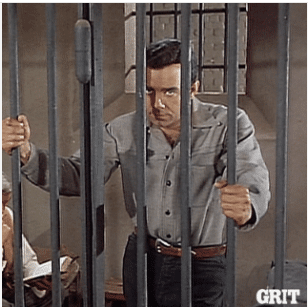
“So what,” you might be asking yourself. “What does this have to do with marketing or branding?”
Well, that’s a fair question. I didn’t see the connection when I started down this rabbit trail 30 years ago.
However, what if you frame it as a problem of brand loyalty?
In a recent Nielsen study, consumers said they are 46% more likely to change brands than they were just five years ago. And only 8% said they were strongly brand loyal.
New Nielsen findings demonstrate that just 8% of consumers consider themselves to be firmly committed loyalists… A whopping 46% of consumers tell us they are more likely to try new brands than they were five years ago…
“Consumer Disloyalty is the New Normal”
That means customers are easier to lose and harder to keep than ever.
When I lost my closest friends to a cult, I was devastated. I had to understand what had happened. What did I do wrong? Why did they leave? More to the point, why didn’t they come back?
I spent three decades studying these questions. I learned that loyalty is the direct consequence of 5 specific behaviors that anyone can copy.
So, what does this have to do with marketing and branding?
Loyalty. Fanatical brand loyalty.
Want to learn how to reverse that trend of customer disloyalty? Of course we do.
It all starts with what I call The 4 Big Questions.
Brand Loyalty and the 4 Big Questions
Every human being enters the world with 4 Big Questions:
- “Where did I come from?”
- “Why am I here?”
- “Where am I going?” and
- “Who am I?”
Now, you may recognize these as the problems of Origin, Purpose, Adventure, and Identity. These questions demand answers.
If we don’t know where we’re from, why we’re here, where we’re going, or who we are, our lives have no meaning. And without meaning, we can’t function.
However, when someone answers those questions for us, we respond with loyalty.
 Now, who do you know who provides both answers to existential questions and enjoys fanatical loyalty?
Now, who do you know who provides both answers to existential questions and enjoys fanatical loyalty?
That’s right, Religion.
And that’s not a coincidence. The form of those answers, however, might surprise you. And it is the form that makes it work.
In my research, I identified 5 bulletproof techniques that Religion uses to deliver those answers and create loyalty. Before I tell you what they are, let me first explain why they work.
 If you cross your legs and someone taps you on the patellar tendon, we know exactly what will happen next. Your lower leg will kick out. You can’t stop it. You can’t control it. It’s a physical reflex.
If you cross your legs and someone taps you on the patellar tendon, we know exactly what will happen next. Your lower leg will kick out. You can’t stop it. You can’t control it. It’s a physical reflex.
Well, humans have emotional reflexes as well. These five techniques trigger the emotional reflex of loyalty.
Do not forget this: Loyalty is a reflexive response to an emotional trigger. It is not a rational decision.
Loyalty is a reflexive response to an emotional trigger. It is not a rational decision.
Okay, enough preamble. What are these five triggers? I created an acronym to help remember them: SPARK. It stands for:
- Story
- Personality
- Anger
- Ritual and
- Keywords.
The cult that captured my friends used all five. And I’ve identified only one company that’s ever used all five: Apple.
Brand Loyalty Spark 1: Story
The first loyalty trigger is Story.
Humans cannot resist good stories. And since we want to trigger feelings of loyalty, then we’ve got to tell a story that answers one of the 4 Big Questions, right?
So, what kind of story would that be?
An Origin Story, of course. Origin stories answer the question, “Where did I come from?”
Now, I know what you’re thinking, “that doesn’t make any sense. People don’t get answers to their own questions from someone else’s story.”
And you’re right, that doesn’t make sense.
Remember though, we’re in the realm of Emotion, not Reason or Logic.
Meaningful lives require answers to the 4 Big Questions, but Meaning itself isn’t logical. Therefore, the answers don’t have to be logical; they just have to fit the right pattern.
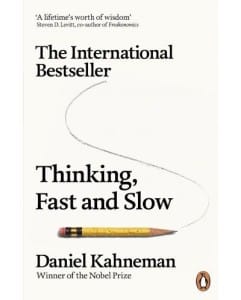 In his book, Thinking Fast and Slow, Nobel Prize winner Daniel Kahneman explains why our brains work this way. It’s basically pattern recognition on steroids.
In his book, Thinking Fast and Slow, Nobel Prize winner Daniel Kahneman explains why our brains work this way. It’s basically pattern recognition on steroids.
See, when people recognize their own pain in a story, they also experience the relief that’s delivered by that story. As long as the story fits the right pattern, it will deliver the right relief.
So, what’s the right pattern?
Joseph Campbell’s Hero’s Journey will always work.
Kurt Vonnegut identified three story shapes that work. He calls them Man in Hole, Boy Meets Girl, and Cinderella.
The cult that stole my friends had a Hero’s Journey story shape. Apple’s origin story shape is Cinderella.
Brand Loyalty Spark 2: Personality
The second loyalty trigger is Personality. A personality combines language and images, sight and sound.
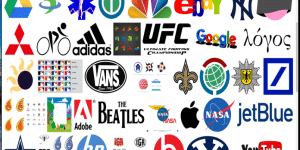 Now we all know that a character diamond makes your brand sound like a real person, but do you know what people think of when they visualize your brand?
Now we all know that a character diamond makes your brand sound like a real person, but do you know what people think of when they visualize your brand?
Most people think of your logo.
Yet research shows that humans don’t form emotional connections to abstractions like logos. We form connections – emotional connections – to faces.
That means you must give people a face to visualize when they think of your brand. Call it a mascot, if you will.
Logos won’t trigger emotional connections. Faces will.
A face and a character diamond makes your brand look and sound like a personality. Combine that personality with a well-shaped Origin Story, and you will provide answers to the problems of Origin and Identity.
Examples?
The cult’s personality was the leader of the cult, a guy named Blair.
 Apple’s personality? Well, it used to be Steve Jobs. Sadly, that’s no longer true, but it didn’t have to be that way.
Apple’s personality? Well, it used to be Steve Jobs. Sadly, that’s no longer true, but it didn’t have to be that way.
Just because Jobs is gone doesn’t mean his face and his personality couldn’t continue to be the face and personality of the company.
Apple squandered that asset. Take a lesson.
Brand Loyalty Spark 3: Anger
The third loyalty trigger is Anger.

Your authentic anger – and the actions you inspire – supply relief to the problems of Purpose and Adventure. Those are the questions of “Why am I Here?” and “Where am I Going?”
Most businesses avoid authentic emotion in their communications. That’s a mistake. Authentic anger is the single most powerful way to attract the hearts and souls of your audience.
Is it risky?
Well, yeah. You must handle it the right way. And I’ll tell you how in a moment. However, when you show this anger is just as important as how you show it.
The right time to be angry is when you’re fed up with a problem everyone has and no one has solved. That’s the perfect time to express your anger.
The best way to express that anger is through a Manifesto.
What is a Manifesto?
 It’s an unreasonable, hyperbolic, passionate and intensely provocative declaration. Its purpose is not to explain, but to inspire. Its sheer unreasonableness is what grabs people’s hearts and won’t let them go.
It’s an unreasonable, hyperbolic, passionate and intensely provocative declaration. Its purpose is not to explain, but to inspire. Its sheer unreasonableness is what grabs people’s hearts and won’t let them go.
Now, a well-formed manifesto has four beats:
- Denounce
- Declare
- Describe
- Divide
You denounce the status quo, declare a solution, describe the glorious future that awaits us once the solution is embraced, and you divide the world into two camps, those who are with you and those who are against you.
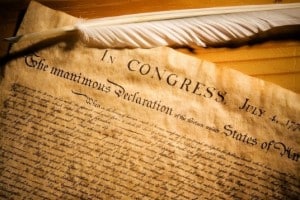 Another way to think of the Manifesto is: it’s simply your “We Believe” statements with the intensity cranked up to 11.
Another way to think of the Manifesto is: it’s simply your “We Believe” statements with the intensity cranked up to 11.
The US Declaration of Independence, as well as Apple’s 1984 ad, were great examples of manifestos.
They each denounced the status quo, declared a solution, described a glorious future once that solution was embraced, and drew a clear line in the sand between the forces of good and the forces of evil.
Brand Loyalty Spark 4: Ritual
The fourth loyalty trigger is Ritual. Ritual provides relief to the problems of Identity and Purpose: “Who am I” and “Why am I Here?”
So, what exactly is a Ritual?
Rituals are physical actions with 5 distinct components.
A ritual is (1) performed with your body, (2) together with other people, (3) at a predictable time, (4) on a regular schedule, and (5) it has no utility. Now, this is vital: ritual is a form of play. You do it because you do it, not to accomplish something.
Ritual is the hardest of the five loyalty sparks to implement, and it is also by far the most powerful.
What’s Apple’s ritual? Well, they’ve got many, but here’s one everybody knows:
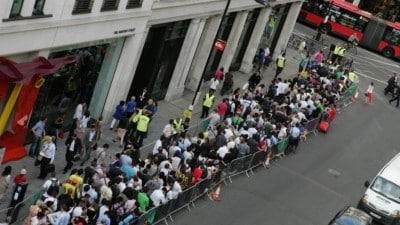
The night before the release of a new product, all the Apple faithful queue up outside an Apple store and spend the night together.
They know when it’s going to happen, and they all do it. It’s a stupid thing. It’s silly. Yet it binds these people to the Apple tribe in a powerful, powerful way.
Brand Loyalty Spark 5: Keywords
The fifth and final trigger is Keywords.
Keywords help to answer the question, “Who am I?” Now this is the easiest of the five to implement, but it’s also the least powerful.
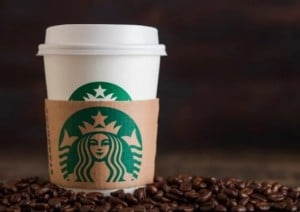 So, what are Keywords?
So, what are Keywords?
Let me explain by example.
The first time I was in Starbucks, it really irritated me that I couldn’t find the word “large” anywhere on the menu.
When it was my turn to order, I explained that I just wanted a large coffee and I couldn’t find it anywhere on the menu.
You already know what the girl behind the counter said:
“Oh, you want a Venti Drip!”
Now the instant I understood that “venti” meant “large,” I experienced this little burst of pleasure. Suddenly I knew what the secret words meant. I belonged. I was on the inside.
To the uninitiated, Keywords amplify the pain of not belonging. However, once understood, they create the pleasure of gaining admittance to the inner circle.
Normally, we use language to convey meaning. However, we use keywords to hide meaning from anyone who is not part of the group.
Keywords can be new words you just make up or existing words you change the meaning of.
Is Brand Loyalty a Myth? (Not If You Do This)
So, to summarize… If you want to create fanatically loyal Fans, Customers, Members – whatever – you must:
- tell the right shaped Story
- display a real Personality
- share your authentic Anger
- observe Rituals and
- communicate in Keywords.
Combine these five Loyalty Sparks with reach and frequency and you’ll deliver relief from the pain of our existential questions.
That’s how you spark the loyalty reflex. That’s how you trigger fanatical loyalty. That’s how you make relationships almost impervious to outside forces.
If you’re ready to make every point of contact with your customer into a “personality encounter” that will transform your slightly-better-than-average brand into a lovable, personable powerhouse brand, we should talk.
- Shared Suffering: The Missing Ingredient in Customer Loyalty - June 25, 2025
- The Unignorable Jingle: Win Hearts & Customers in 8 Seconds - June 17, 2025
- The Metric Trap Sabotaging Your Marketing - April 17, 2025
